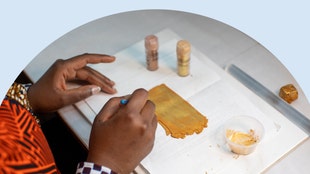This article is intended as a practical guide for sellers to address common product safety questions. Sellers are ultimately responsible for the safety and compliance of their products.
Friendly disclaimer: If you list products for sale on Etsy, you must comply with all applicable federal, state, and local legal requirements and Etsy policies applicable to those products and product listings. This information provides an overview regarding non-exhaustive EU requirements for educational purposes only, is subject to change over time, and is not legal advice. It is not intended to create, and receipt of it does not constitute, a lawyer-client relationship. The authors, Etsy, Inc. and Etsy Ireland UC disclaim all responsibility for any and all losses, damages, or causes of action that may arise or be connected with the use of or reliance on these materials. Requirements may vary depending on your location and where you make your products available. Etsy reserves the right to remove listings of products that do not comply or that may be unsafe for any other reason.
How is clothing defined in the EU?
Clothing is generally considered a textile product. A “textile product” means any raw, semi-worked, worked, semi-manufactured, manufactured, semi-made-up or made-up product which is exclusively composed of textile fibers. In the EU, all products that contain at least 80% by weight textile fibers are covered by the EU Regulation for textile products.
In addition to the Textile Regulation, clothes must comply with the Regulation on Registration, Evaluation, Authorization and Restriction of Chemicals (REACH), as well as with the General Product Safety Directive (GPSD) and Market surveillance Regulation. Additionally, some textile products are not considered apparel, but fall within the scope of other regulations or directives. For instance, if you sell personal protective products, such as masks, gardening gloves, and protective sportswear, the Personal Protective Equipment (PPE) Regulation applies as well. If you add biocides to textiles to protect humans, animals, materials or articles against harmful organisms, the EU’s Biocidal Product Regulation (BPR) also applies.
It is your responsibility as an Etsy seller to make sure that your textile products are safe and comply with all the applicable Regulations and Directives.
What are the labeling and marking requirements to sell clothing in the EU?
Clothing sold in the EU must be labeled or marked to show its fiber composition. Please see below for an explanation on fiber content labeling. However, there are certain textile products for which labeling or marking is not mandatory. Such products are listed in Annex V of the Textile Regulation. Other products, instead, have special provisions. Such products are listed in Annex IV of the Textile Regulation. Some examples of products subject to special provisions are: corsetry products, etch-printed textiles, velvet and plush textiles, and certain floor coverings and carpets. The special provision for each product can be found in the mentioned Annex.
Overall, textile products may not be CE marked if they fall under the scope of the Textile Regulation, GPSD, or BPR. However, products that are considered Personal Protective Equipment or Toys (such as children’s costumes and dress-up products) must have CE marking. Other than CE marking, selling PPE and Toys also requires further safety standards for the design, manufacturing, material use, testing and user instructions.
What should be written on the label?
The labels or markings must specify the fiber composition, using the fiber names listed in Annex I of the Textile Regulation.
You must write the composition in decreasing percentage order, using clear and uniform text and lettering. There must also be a clear separation between the information on fiber composition and other information.
The text must be in all the official national languages of the countries where you want to sell.
The label or mark should indicate the fiber composition in a durable, easily legible, visible, and accessible way. The label must be securely attached.
Do apparel labels need to include information about size, care, and country of origin?
EU law does not currently require including label information such as “Made in”, size, or care instructions. However, including this information is highly recommended, because some individual member states may require such information. You may consider following standard ISO 3758: 2012
Does the Textile Regulation also apply to self-made clothing?
The Textile Regulation does not apply to customized textile products made by self-employed tailors. Particularly, the above-mentioned labeling and marking requirements do not apply in following cases:
- people working in their own homes making customized textile products;
- independent firms carrying out work from materials supplied to them as a gift or donation;
- self-employed tailors making customized textile products.
These exemptions are limited to the circumstances indicated in Article 2 of the Textile Regulation.
Also when the Textile Regulation might not apply, other regulations mentioned in the section “How is clothing defined in the EU?” will apply.
Are there fabrics or materials that are prohibited in apparel sold in the EU?
Yes, there are materials that are not allowed or restricted in textiles in the EU, such as certain azo dyes, flame retardants, waterproofing and stain-repelling chemicals, and nickel. The REACH Regulation addresses such restrictions or bans. The REACH Regulation applies to all chemical substances in a wide range of products, including clothes and accessories to clothes, such as zippers or buttons.
You can find the Restricted Substances List in Annex XVII to the REACH Regulation. You can also check what your obligations and exceptions are in the ECHA website, the website of the European Chemical Agency.
You must ensure that your products only contain allowed materials within limits set in the EU law.
Can I sell products made of materials derived from wild plants and animals?
The Regulation on the protection of species of wild fauna and flora restricts the use of materials derived from wild plants and animals in trade. Some materials derived from plants and animals are banned, while some others are subject to restrictions. You can consult Annexes A, B, C, and D of this Regulation for more information on restricted and banned materials.
How can I sell children’s wear?
Children handle clothes differently compared to adults. Therefore, there are other risks and safety requirements to consider when selling products for babies and children.
In addition to the general requirements for apparel, children’s wear and babywear must comply with special safety requirements. You can only sell clothing that is considered safe under the General Product Safety Directive (GPSD). In particular, children’s wear and babywear must comply with safety standards addressing the risks of strangulation, injury, and entrapment posed by cords and drawstrings. Accessories, such as buttons, that are small and could be ingested or could cause suffocation, must be firmly attached.
Are there any additional requirements for children’s nightwear (sleepwear)?
In addition to the General Product Safety Directive (GPSD), the EU has published voluntary standards concerning the flammability of children’s nightwear. Nightwear is defined as “Garments that are either sold as nightwear or intended to be worn as nightwear, e.g. bathrobes, dressing gowns, nightshirts, nightdresses and pyjamas”. Such standard applies only to children’s nightwear and not to nightwear for babies, which is for babies up to 6 months old, corresponding to height up to 68 cm. The procedure to comply with this flammability standard is described in EN 1103:2005 “Textiles – Fabrics for apparel – Detailed procedure to determine the burning behaviour”. As a result, children’s nightwear must be in fire-resistant materials in order to prevent dangerous accidents.
The European Union has no EU-wide specific legal requirement related to clothing flammability. However, several countries in the EU do. In such cases, these additional national requirements apply.
What other non-clothing products are covered by the Textile Regulation?
All textile products that meet the composition requirement (at least 80% by weight of textile fibers) are covered by the Textile Regulation. However, for some non-clothing textile products, the labeling or marking requirements are not mandatory. The list of products exempted from labeling or marking requirements can be found in Annex V of the Regulation. Some examples of such products are: sleeve-supporting armbands, watch straps of textile materials, coffee and tea covers, artificial flowers, painted canvas, travel goods of textile materials, book covers of textile materials, buttons and buckles covered with textile materials, toys, oven gloves and cloths, makeup cases, animal clothing, flag and banners, and others.
Also when not explicitly mentioned, the Textile Regulation covers further textile items such as gloves, swimwear, scarfs, and similar if they meet the composition requirement (80% Textile products). Annex I lists all fibers covered by the Textile Regulation.
When no other regulation or requirement applies, the General Product Safety Directive (GPSD) always applies.
How can I sell clothing in the United Kingdom?
Since Brexit, the United Kingdom is not part of the European Union anymore. Therefore, the EU legislation does not apply if you want to sell in the United Kingdom. To sell clothes in the United Kingdom, your products need to comply at least with the Textile Products Regulations as well as with the General Product Safety Regulations. Depending on the type of products and the intended use, more Regulations might apply.
According to the UK Textile Products (Labelling and Fiber Composition) Regulations, textile products must respect the following main requirements:
- They must carry a label indicating the fiber content, including fur and other animal parts. Especially, you must pay attention to the fiber percentage contained in each textile.
- The labels should be durable, easy to read, and visible
- Only certain names can be used for fiber. They are listed in Annex I to Regulation (EU) No 1007/2011;
Further labeling requirements are illustrated in this Guidance on textile labeling published by the UK government.
Moreover, to help yourself classify textile apparel for the United Kingdom, you can consult this Guidance published by the UK government. The Guidance includes classification of adult and baby clothing, occupational and industrial clothing, accessories, and similar. Comparable to the EU legislation, occupational and industrial clothing also have to comply with the UK Personal Protective Equipment Regulations.
 Words by Etsy Staff
Words by Etsy Staff




